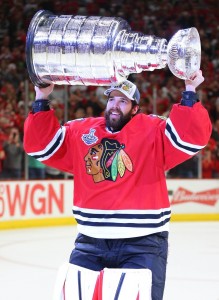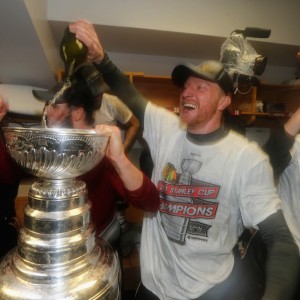Measuring oneself against the reigning champions is a special opportunity for players and coaches alike. Over the next week the Devils will have that chance twice–hosting the Chicago Blackhawks Friday at home and again on Nov. 12 in Chicago.

Heading into their first of two meetings on the season, the Devils sport a 6-5-1 record that’s particularly admirable when considering where most experts had the team pegged to finish. It’s a little too early to tell anything from the standings just yet, including the Blackhawks 7-5-1 record which has them sitting sixth in a stacked Central division.
The Blackhawks third cup in six seasons might be the closest thing to a dynasty in a salary cap era where retaining talent and team balance has proved to be difficult. The Devils three cups in nine years from 1995–2003 were done so in a cap-less era, though operating under tight budgetary constraints.
In-House Roster Assembly
When the Blackhawks hoisted the Stanley Cup at the United Center last June, they had 11 players who were drafted by the franchise between 2002–2012. Of the 11, just one (Brandon Saad) was not on the opening roster for the 2015-16 campaign.
The Devils had 12 players drafted by the franchise in 2003 when they won the organization’s third and most recent Stanley Cup. Heading into 2003-04 the only player that did not return to the franchise was Ken Daneyko (retirement).
Since then, the Devils have had 11 or more drafted players on the roster for over 30 percent of the season just twice, and under 10 drafted players six times, including this season. That number however does not include players
originally drafted who returned via free agency (Jim Dowd-2006-07; Mike Rupp-2006-09; Scott Clemmensen-2008-09, 2014-15; Cam Janssen-2011-14; Petr Sykora-2011-12; Scott Gomez-2014-15). Also not included were the number of collegiate/junior hockey free agents who opted to sign their first professional contracts with the Devils, some of those players include Brian Rafalski, Andy Greene and David Clarkson.
At the Draft Table
The Blackhawks have done well for themselves in the draft–finding the likes Niklas Hjalmarsson, Andrew Shaw and Marcus Kruger in the later half (100+ picks in) of the draft. Meanwhile the club has utilized their earlier round picks on the likes of Duncan Keith, Brent Seabrook, Corey Crawford, Brandon Saad and Teuvo Teravainen. This, added to a lottery pick in 2007 to select Patrick Kane and Jonathan Toews slipping to third overall at the 2006 draft have helped shape the core of the NHL powerhouse.
At one point, the Devils drafting was among the best in the NHL. It’s cooled in recent years and the struggles at the table have been magnified by an inability to keep what they had. Unrestricted free agency has seen the likes of Scott Niedermayer, Scott Gomez, Paul Martin, Zach Parise and Mark Fayne all depart. Meanwhile the Devils only free agent signing in recent memory to pan out (and by pan out I mean, stick around for the contract duration) was Dainius Zubrus, who signed a six-year, $20.4 million dollar contract in 2007. He would sign a three-year contract in 2013, ultimately being bought out in 2015.
On July 1

The Blackhawks drafted core that has won three cups together hardly calls for much aid via free agency. The team did sign Marian Hossa to a 12-year, $62.8 million dollar contract in 2009, and Hossa has gone on to be part of that core. Since then, Stan Bowman has opeted to focus on its own, signing Keith, Crawford, Kane, Toews and Seabrook to long-term deals.
The Devils are still trying to decipher their core–though a seven-year contract extended to Cory Schneider; a five-year deal to Andy Greene and an eight-year contract to Travis Zajac are notable as the transitioning Devils look to return to contender status.
When measuring the two franchises though on the merit of drafting and player procurement, the Hawks have a decidedly favorable advantage. Which has made the latest era under Ray Shero all the more important. He, along with a new staff assembled from head-to-toe will be charged with helping the Devils emulate what the Blackhawks have done–draft, develop and most importantly, keep their talent.